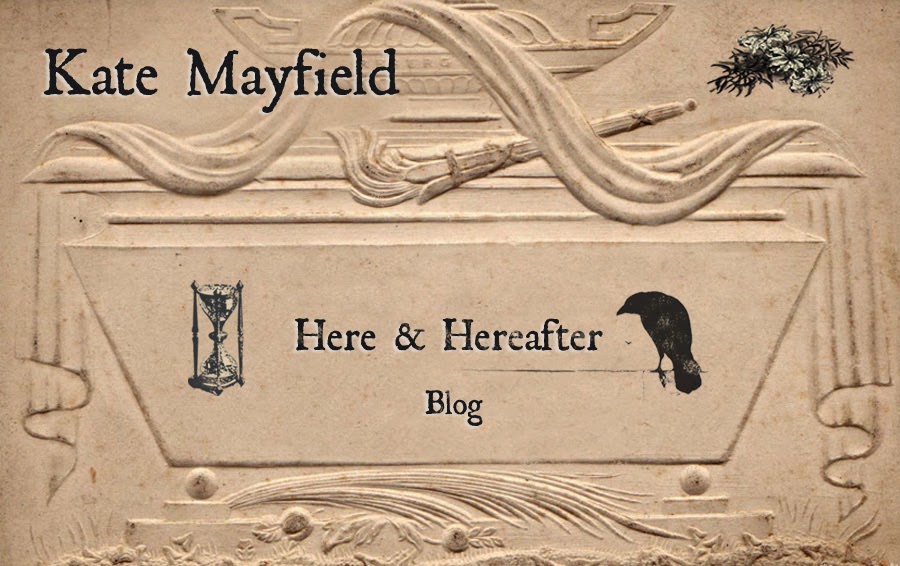“Today at the cemetery I found a tombstone with pictures on it! They had these oval brass frame things around them!”
My untameable glee gave my classmates the heebie-jeebies. In unison they slowly backed away from me. Undaunted, and fascinated by the two small mausoleums in our cemetery, I voiced my appreciation for the way the tombstones poked up around the stone buildings and complimented the overall design.
I counted angels and crosses and made up stories of the people buried beneath the shaded green carpet while my father went about his business. There was no escaping the smell of damp earth or the poignancy of an unkempt grave. The dirt of the cemetery was often caked in the soles of our shoes, the dust of fallen leaves clung to our socks, though, amazingly, the tops of my father’s shoes remained spotless and shiny.
I couldn’t fathom why cemeteries were associated with ghouls and zombies when they were always intended to be a place of peace.
In Victorian England cemeteries were newly landscaped, designed as a destination for contemplation, a lovely place for a stroll. A satisfying Sunday day out often included a visit to the cemetery, perhaps a picnic on the perfectly manicured grounds.

Yet, something wicked and dark haunted grieving families even before the Victorians designed their park and garden-like cemeteries. The peace was often shattered by a violation that struck fear and horror in the mourning public. The work of Resurrectionists, grave robbers, body snatchers, or “sack-um-up men” that thrived particularly in early 19th century England is fairly well known. Scientists and surgeons created the demand that eventually became a colossal tumbleweed, collecting bodies along its way.





And still there were not enough bodies to go around.
A particularly blunt advertisement from a Dr. T. Stillman, directed at slave owners:
“To planters and others—wanted 50 Negroes. Any person having sick Negroes, considered incurable by their respective physicians, and wishing to dispose of them, Dr. S. will pay cash for Negroes affected with scrofula, or King’s evil, confirmed hypocondriasm, apoplaxi, diseases of the liver, kidneys, spleen, stomach, and intestines, bladder and its appendages, diarrhea, dysentery, etc. The highest cash price will be paid on application as above.”
And still there were not enough.
After the Civil War, myths and tales of needle men and black bottle men in Louisiana haunted the disenfranchised. The body count of these alleged murderers surpassed Scotland’s notorious Burke and Hare. Charity Hospital in New Orleans, the second oldest public hospital in the United Sates by only one month to New York’s Bellevue, was rumoured to go to great lengths to obtain cadavers.

Charity Hospital New Orleans
"I sure don't go out much at this time of year. You takes a chance just walkin' on the streets. Them Needle Mens is everywhere. They always comes 'round in the fall, and they's 'round to about March. You see, them Needle Mens is medical students from the Charity Hospital tryin' to git your body to work on. That's 'cause stiffs is very scarce at this time of the year. If they ever sticks their needles in your arm you is jest a plain goner! All they’s gotta do is jest brush by you, and there you is; you is been stuck.”
From Gumbo Ya-Ya: A Collection of Louisiana Folk Tales by Lyle Saxon, Edward Dreyer, Robert Tallant

Similar to the needle men in intent were the black bottle men; medical students who stood at the door of Charity Hospital where upon admission they administered a dose of lethal poison to incoming patients. In reality, the dose was cascara, black in colour, made dark brown when magnesia was added, a diuretic frequently given to patients after admission. But tales were that it was thought to speed death along its path and given to those on the brink. I don’t know, but where there’s smoke…
This then was the kernel of truth attributed to the tales of the “night doctors” that spread throughout the rural South. Emerged from the realities of medical experimentation, body snatching and murder, whites told African Americans gruesome tales of medical experimentation, taunting them with threats of kidnapping.
The exodus of freed slaves to the north hastened the crumbling of the South’s post war economy. Southern whites hoped to dissuade Freemen from moving to northern cities to work. In an era when superstitions were considered as real as a plate of biscuits with red-eye gravy, whites roamed African American neighborhoods at night to spread fear, covering themselves in white sheets, pretending to be spirits coming to claim them for dissection. The similarity in appearance of the night doctors and the white-robed Ku Klux Klan lead some individuals to refer to the night doctors as “Ku Klux doctors”.

